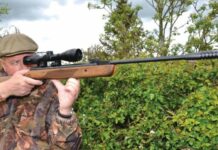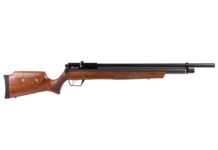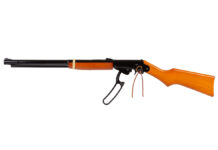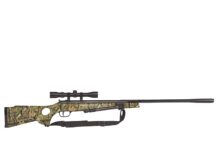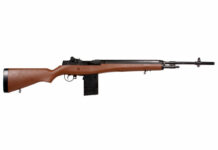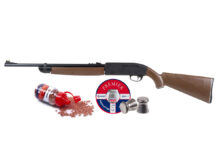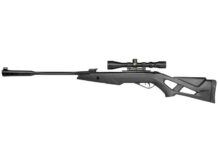By Daniel Allred
Click the image below to read the story in the original layout.
There’s no easy way to sum up a company as legendary as PSE. After all, the history of PSE goes hand in hand with the history of the compound bow itself.
Established in 1970, PSE was one of the five original companies that developed and manufactured compound bows. Today, half a century later, it is the only one of those five original companies that’s still developing products and pushing the limits of archery technology.
Pete Shepley has made countless contributions to the archery industry. Some of the contributions were technical advancements, and others were for the betterment of archery in general. Today, Shepley remains the leader of his company, and he is as dedicated as ever to improving archery technology and supporting the industry at large.
Much of PSE’s enduring success is thanks to its renowned founder and CEO, Pete Shepley. Under the guidance of this industry pioneer, PSE has evolved into a definitive leader of compound bow technology. Shepley has continually elevated his products and improved his manufacturing techniques to stay ahead of the curve. He didn’t just adapt to the changing bow market—he helped define it.
Now, with 50 years of growth and innovation behind it, PSE is entering a new era. Pete Shepley and his team continue to deliver the engineering expertise and industry knowledge that served them well in the past, and the company has also made modern updates that will ensure its continued success for the next 50 years and beyond.
Lonnie Workman (left) and David Kronengold are key players in PSE’s senior leadership team. Much like Pete Shepley, they both fell in love with archery at a young age and went on to pursue it professionally.
A Blueprint for the Modern Bow – From Then to Now
Pete Shepley’s relationship with archery and bow building began long before he was making compound bows with PSE. Here’s how he described the beginning in his own words:
“Archery started for me in the mid 1940s,” Shepley said. “I spent summers on a farm in Rockford, Illinois, with my grandpa, and he was a real outdoorsman. We fished and hunted and everything else, but more importantly, we made bows out of Osage orange. Those bows would dry out and break every 30 days or so, so we were always making new ones. He also bought me a new wooden arrow every week when I was working on the farm, and I deeply treasured each one of those arrows.”
Pete Shepley has remained an avid completive shooter since his teens. This deep passion for the sport has been a major factor behind PSE’s enduring success.
From this early introduction to the sport, Shepley went on to compete in archery tournaments in his teens. Shepley’s first tournament was in 1949, and he has remained a diehard competitor ever since. In fact, Shepley was recently a competitor in the 2020 Vegas Shoot.
An avid tinkerer by nature, Shepley graduated from high school and then earned a mechanical engineering degree. From there, Shepley took a job at Magnavox, where he developed missiles and other weapon systems for the U.S. government for 10 years. His passion for archery never faded during this early stage of his career, though. With cutting-edge tools and materials at his disposal, Shepley used his knowledge of engineering and archery to create a handful of revolutionary items that we take for granted today.
“I worked on a lot of military projects at Magnavox, but all of that time I was also making archery products,” Shepley said. “There was a machine shop set up for us engineering guys, and when everyone else went to lunch I would build things. I made arrow rests and sights, and that’s also where plastic vanes came from. I also made one of the first release aids in those days, and a lot of other little toys.”
In addition to being a devoted target shooter, Pete Shepley is also a diehard and prolific bowhunter. His bowhunting adventures have taken him around the world many times to pursue unique game.
All of these “toys” were developed in the days of recurve bows, and as history has clearly shown, everything changed for Shepley with the advent of the compound bow.
Shepley left Magnavox to establish his own business, and soon PSE became the fifth company to lease Holless Wilbur Allen’s patent for the compound bow. PSE’s first compound bow design was an almost instant hit. Shepley, along with two of his friends, unveiled the first PSE compound at an archery tournament in Indiana. The three of them placed first, second and third, and Shepley sold 200 bows in that weekend alone. In the following months, archers all over the country were trying to get their hands on a PSE compound.
Over the years, Shepley continued to prove again and again that he was a brilliant engineer of archery products. PSE became an internationally acclaimed manufacturer, and it has remained a top player in the industry until the modern day.
Under One Big Roof
But Shepley is also the first to admit that he didn’t do it all alone. As his company grew, so did his staff, and after so many years in business, his staff has become incredibly gifted. Today, PSE employs around 175 employees at the company’s 150,000-square-foot manufacturing facility in Tucson, Arizona, and an increasing number of these employees have been with the company for decades.
Shepley has also assembled a dedicated leadership team with the same values, work ethic and passion for archery as him. Two prime examples are David Kronengold, general manager; and Lonnie Workman, vice president of sales and marketing. Much like Pete Shepley, David Kronengold and Lonnie Workman fell in love with archery at a young age. Also much like Shepley, their passion eventually led them to a career in the archery industry.
This humble building in Mahomet, Illinois, was PSE’s original facility. After steady growth, the company relocated to Tucson, Arizona, in 1982, where it remains to this day.
David Kronengold was born and raised in New Jersey, where he first tried archery at a summer camp. This taste of the sport prompted Kronengold to seek professional coaching and pursue Olympic-style shooting. Intent on working in the archery industry, Kronengold then earned a mechanical engineering degree at MIT and was hired by PSE shortly after graduation.
Lonnie Workman took a different path, but he arrived at a very similar location. Born and raised in West Virginia, Workman considered bowhunting as a rite of passage. He went on to earn an economics degree and work in banking for 10 years, but bowhunting remained his true passion. One day, he sent an application to PSE out of the blue, and he was hired 24 hours later.
For Pete Shepley, a passionate workforce has been a key part of his company’s lasting success.
PSE’s manufacturing facility is also equipped with a spacious event center and outdoor range. The company uses these areas to host events and offer advanced coaching.
“They know bows and arrows as well as I do, and they also just love archery and want to be involved,” Shepley said. “They aren’t just looking for a dollar—they’re in it for the long haul. They want to make the sport grow, and they want to make truly great equipment. If they don’t enjoy it, then we will find out. Manufacturing is difficult. They won’t last long, and they will just move on and find something else that’s easier.”
As a fellow mechanical engineer and diehard archer, David Kronengold has a deep appreciation for the many technical milestones that Shepley and PSE have achieved over the years. For him, PSE’s legacy is a point of pride and proof of the company’s highly innovative approach.
“The fact that PSE has been making compound bows since the early days is a major achievement on its own,” Kronengold said. “But then PSE stayed on the forefront of technology in the 80s, 90s and 2000s. We weren’t the first, but we were one of the first to have CNC-machined aluminum risers. After that, we developed our patented extruded aluminum riser, which brought our technology down to a lower price point. In the mid-1990s, PSE had the first commercially available mass-manufactured carbon riser. Although we were not the first, we were on the front line of bringing single cams to the market, and we were also one of the first to use highly pre-loaded limbs, which are now very common in the market. On top of all that, we have regularly led the speed game. We’ve always had—if not the fastest bow—the most shootable fast bow in the industry.”
As PSE’s bows have improved, so has the company’s manufacturing facility. PSE remains dedicated to U.S. manufacturing, and the facility has grown over the last five decades to fulfill a wide variety of needs. Today, PSE’s Tucson facility has everything required to build a modern bow from scratch.
A proud U.S. manufacturer, PSE creates its bows from scratch at the company’s 150,000-square-foot manufacturing facility in Tucson, Arizona. The company currently employs about 175 employees, and many of these workers have been with the company for decades.
“We’ve always been pushing the limits of our manufacturing technologies,” Kronengold explained. “We started using CNC machines in the early days, and now we have a very large CNC department. In the mid-2000s, we started cutting fiberglass and manufacturing pultruded limbs. Just this last year, we brought our carbon riser manufacturing in house. We also manufacture our Livewire bowstrings here, and we do injection molding, anodizing, powder coating, dye-sublimation and hydrographic decoration—pretty much everything that’s involved in the process. We bring the raw materials in, and we do everything here.”
Other key aspects of the company are also found here, allowing PSE to operate as a truly streamlined machine.
“Pete has always promoted vertical integration,” Kronengold said. “All of these manufacturing technologies give us the ability to quickly and precisely manufacture the designs that are coming from our advanced engineering department. All of our marketing is also done here in house, and we have sales reps who work for the company. They are not independent reps; they are PSE employees. We handle our customer service here in house, too. Pretty much everything we do takes place under one roof.”
The fact that the company is making its own carbon risers is particularly important to PSE’s leadership team. It serves as a testament to the company’s dedicated staff and manufacturing expertise.
“We have an incredibly engaged workforce that is willing to go the extra mile,” Kronengold said. “Last year they proved that when we asked them to do something that seemed impossible: to start manufacturing carbon risers here in the building. It took a while to learn the process, but we are now the only domestic manufacturer of carbon risers in the industry, and by bringing that process in-house, we have even more control over it. We’ve been doing it for about five months, and now we are just keeping up with the demand. We just hired a second shift and we are still hiring for a third shift, so we will be making carbon risers 24 hours a day, 7 days a week.”
For 2020, PSE is using its state-of-the-art facility to bring some powerful new innovations to the market. In addition to a cutting-edge lineup of compound bows, PSE also unveiled its new Warhammer crossbow.
“Pete actually invented the compound crossbow in 1978, and we’ve made crossbows ever since,” Workman said. “Some years we have been more innovative than others, but we are really getting back into it with the new Warhammer. It is a 100 percent domestic-manufactured high-end crossbow. It’s compact—with a 6.125-inch axle-to-axle measurement at full draw. It’s lightweight, balanced and extremely maneuverable. It’s also very accurate and easy to shoot. A lot of testing has been done on this crossbow. It is truly top-of-the-line, and it’s made from scratch right here in Tucson.”
As a vertically integrated manufacturer, PSE creates, assembles, packages and ships its products after starting out with raw materials.
An Industry Advocate
Excellent engineering has clearly been central to PSE’s lasting success, but behind the scenes, Pete Shepley has also always been a devoted advocate for the industry.
This is only fitting for one of the archery’s greatest pioneers. Shepley has dedicated his life to archery, and he wants archery to grow and succeed in all of its forms.
To that end, PSE acknowledges that both bowhunting and target shooting play their own vital roles. For Pete Shepley, PSE’s recent investment in target archery has been a full-circle experience.
“In the beginning, we focused pretty much exclusively on target archery, because that’s just what I was really interested in,” Shepley explained. “I used to have a lot of conversations with Fred Bear. He would call me in his later days, and we would talk about what I was up to. He always said, ‘Pete, target archery is a lot of fun, but you’re not going to get anyone recognizing you until you start shooting some big animals.’ That kind of changed my direction, and we started focusing a lot more on hunting.
“Recently, though, target archery has come back to the forefront for PSE,” Shepley continued. “I have always thought that target archery was great for pro-shops and the industry. I think if you start ten people in target archery, nine of them will go bowhunting. But if you start ten people in bowhunting, very few of them will get into target shooting. We like customers who do both, because then they are in shops all year—instead of just during hunting season. Today we are focused on tournament shooting every bit as much as hunting.”
In addition to developing revolutionary target bows, PSE has also partnered with top professional shooters and supported important organizations like S3DA and World Archery.
“We realized that PSE could have a lot more presence in target archery, so we have made some transitions in the last 18 months or so,” Kronengold said. “We are pushing products in that direction. We are pushing marketing efforts in that direction. We are also doing promotional events and even partnerships in that direction. We recently partnered with S3DA, and we have just signed a partnership with World Archery while we were at the Vegas Shoot. It’s very important for us to seek out and support these organizations. We want more archers to show up and play the game, and we want to make sure that PSE is an obvious choice when they buy their first bow or next bow.”
PSE’s robust collection of partnerships also gives the company ample access to industry experts.
“All of our partners bring value to the team, and everyone brings different value,” Kronengold said. “Some of our pro-staff members are incredibly technical, and they engage in a lot of conversations with our product development team. Others are not as technical, but they are tremendous influencers, and they understand that their job is to spread the word by going to events and winning, or showing up to a hunt and killing the biggest animal. We are constantly having conversations with the best hunters and the best shooters, and we make them actual members of our team. We don’t just sponsor them and give away products. We speak with them on a daily basis. They are our eyes, ears and mouth. They give us critical feedback, and they also get the message out and drive consumer demand.”
With 50 years in the business, PSE also understands that a thriving industry requires thriving dealers. Accordingly, PSE considers its dealers as essential partners.
“I still talk with dealers on a daily basis,” Workman said. “That’s extremely important to me. I want to know what they are seeing in the industry, and I want to know what they are looking for. I want to know what PSE is doing right, and I want to know what we can do better. That’s why I talk to dealers personally on a daily basis. They’re our main customers, and they are paramount to our success. We are always listening, and they have a ton of influence on our buying programs, products and everything else we do.”
Altogether, PSE has a long list of benefits for its pro-shop partners.
“We make a bow at every price point, from entry-level bows all the way up to high-end target bows and carbon bows,” Workman said. “At every price point, we offer very shootable, high-quality bows, and they provide the best value for the money. Our lower-price bows have less bells and whistles, but they are extremely good products. We are also focused on providing our dealers with the best margins possible in the industry. We need to help them make money, so we are very aggressive with our pricing and buying programs. We need shops out there with ranges, classes, JOAD, S3DA, etc. Those shops are truly the lifeblood and future of the industry, and we’re doing everything we can to support them.”
Ultimately, PSE’s partnership efforts play into the company’s big-picture strategy of protecting and growing the industry itself.
“We acknowledge that the industry has challenges, and we make it our day-to-day mission to find solutions,” Kronengold said. “Some of those solutions are straightforward, and others are incredibly challenging, but we are not and we have never been the type of organization that sits and waits for other people to do something for us. That’s why our manufacturing is vertically integrated, and that’s why we take an aggressive stance on the things that we feel passionately about. The industry is in a hard place, but we are not going to wait for anyone else to fix it for us. We are going to make it part of PSE’s business strategy to drive improvements and fix everything we can. And we are doing all of this while fully acknowledging that if we are successful, then we are also benefiting our competitors.”
Conclusion
You can’t argue with 50 years of success. Pete Shepley and his dedicated team clearly know something that others do not.
Perhaps PSE’s lasting success is the product of excellent engineering, or perhaps it is the company’s ability to constantly stay ahead of the curve. Maybe it’s the company’s veteran employees and commitment to American manufacturing, or maybe it’s because industry legend Pete Shepley remains at the helm.
The obvious answer is that PSE’s success is a combination of all these factors, but there is something else at play. Beneath all the company’s engineering breakthroughs and industry-focused decisions, there is a deep sense of love for archery.
“Archery has been my whole life,” Shepley said. “It’s been David’s whole life and Lonnie’s whole life, too. Everyone here loves the sport and loves the people in it. It’s fun to make the equipment and introduce it, but all we want to do is grow the sport. We figure that we will get our piece of the pie if we succeed. We are going to keep working hard every day, and we are going to stick together with the rest of the industry to grow the sport. I want to see more hunters getting into target archery and more target shooters getting into hunting. I want to see families shooting together, and I want to see a lot more kids doing it. The industry can support thousands of new archers. We need more participation, and we are going to keep doing everything we can to grow participation.”




